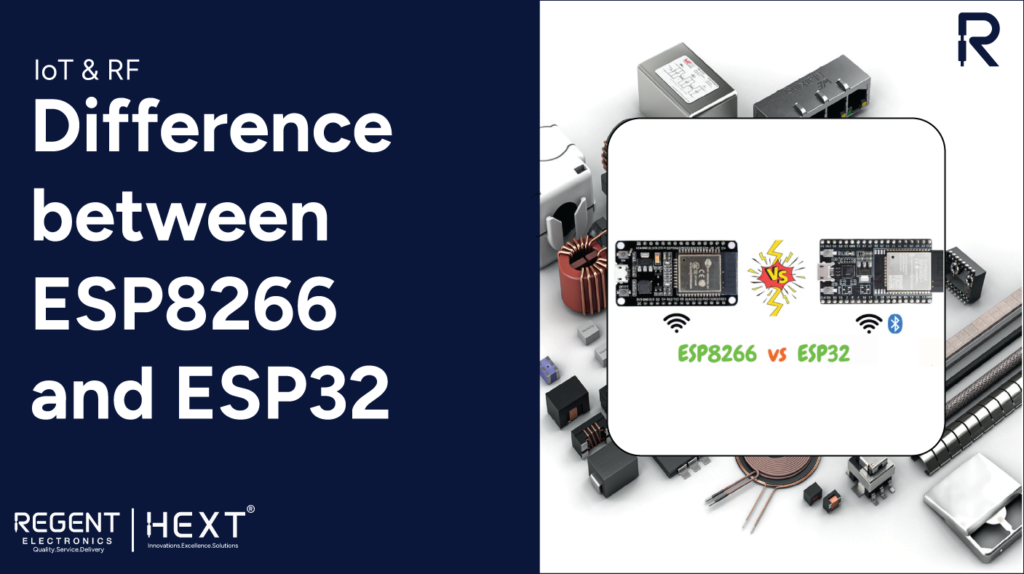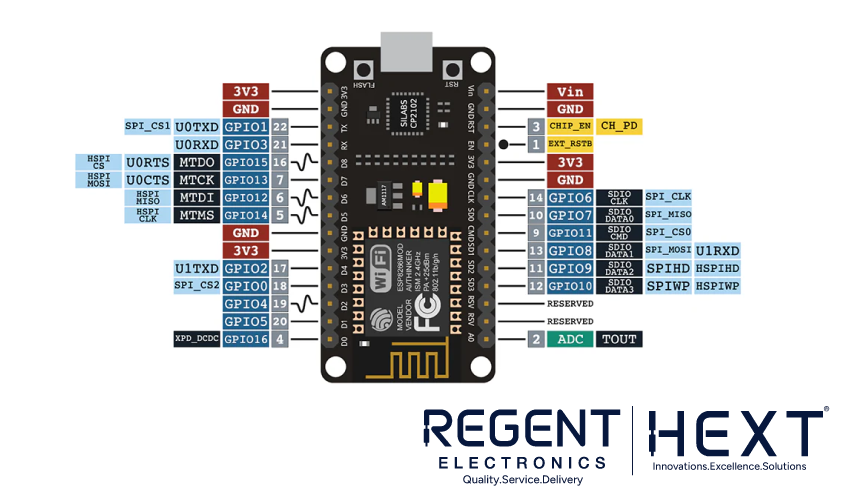
A Comprehensive Comparison of ESP8266 vs ESP32 for IoT Projects: Which One Should You Choose?
When working on IoT (Internet of Things) projects, the ESP8266 and ESP32 are two of the most popular development boards. These Wi-Fi-enabled microcontrollers are affordable, versatile, and come with great features for DIY electronics and home automation projects. But how do you choose the right one for your needs? In this blog, we’ll break down the key differences between the ESP8266 and ESP32, comparing their hardware, features, and capabilities to help you decide which is the best fit for your next IoT project.
What is ESP8266?

The ESP8266 is a low-cost, Wi-Fi-capable microcontroller that allows IoT devices to connect to the internet. It’s a popular choice among hobbyists and makers for its ease of use and affordability. The ESP8266 development board, like the ESP-12E, integrates a Tensilica Xtensa 32-bit LX106 RISC microprocessor. Operating at clock frequencies of 80 to 160 MHz, it is powerful enough for most IoT applications.
Key features of the ESP8266:
- Wi-Fi: It supports 802.11 b/g/n with HT40 for a stable Wi-Fi connection.
- Processor: A single-core 32-bit processor running at 80 MHz.
- RAM: 128 KB RAM and 4MB of flash memory, which is suitable for handling data and web pages in IoT applications.
- GPIO Pins: 17 GPIO pins available for external devices and sensors.
- Power Supply: Requires a 3.3V power source, but can be powered from a 5V USB source via a voltage regulator.
What is ESP32?

The ESP32 is the successor of the ESP8266, offering advanced features and greater processing power. It’s a dual-core microcontroller that runs on a Tensilica Xtensa Dual-Core 32-bit LX6 processor, which offers higher performance for more demanding applications. With Bluetooth support and improved wireless capabilities, the ESP32 is perfect for a wide range of IoT projects that require more than just Wi-Fi connectivity.
Key features of the ESP32:
- Wi-Fi & Bluetooth: In addition to the 802.11 b/g/n HT40 Wi-Fi, it also supports Bluetooth 4.2 (classic and BLE).
- Processor: Dual-core 32-bit processor running at 160-240 MHz, providing up to 600 DMIPS (Dhrystone MIPS).
- RAM: 520 KB of SRAM, 4MB of flash memory, and 448 KB of ROM for better performance and storage.
- GPIO Pins: 36 GPIO pins with support for multiple functions, including PWM, I2S, UART, and SPI.
- Power Supply: Like the ESP8266, the ESP32 operates on 3.3V, but can be powered via a 5V USB source.
ESP8266 vs ESP32: Key Differences
| Specification | ESP8266 | ESP32 |
| Processor | Single-core 32-bit | Dual-core 32-bit |
| Clock Speed | 80 MHz to 160 MHz | 160 MHz to 240 MHz |
| Wi-Fi | 802.11 b/g/n HT20 | 802.11 b/g/n HT40 |
| Bluetooth | No Bluetooth support | Bluetooth 4.2 (BLE + Classic) |
| RAM | 128 KB | 520 KB |
| Flash Memory | 4 MB | 4 MB |
| GPIO Pins | 17 GPIO pins | 36 GPIO pins |
| Analog Pins | 1 ADC Pin (10-bit) | 18 ADC Pins (12-bit) |
| PWM Channels | 8 Channels | 16 Channels |
| Touch Sensing | Not available | 10 Capacitive touch GPIOs |
| SPI/I2C/UART | 2/1/2 | 4/2/2 |
| Operating Voltage | 3.3V | 3.3V |
Performance Comparison
The ESP32 offers significant improvements over the ESP8266 in terms of processing power, GPIO capabilities, and wireless communication options. While the ESP8266 is limited to Wi-Fi communication, the ESP32 adds Bluetooth functionality, making it a more versatile option for projects that require both wireless connectivity options. Additionally, the ESP32’s dual-core processor makes it ideal for tasks that require more intensive processing or multitasking, while the ESP8266, with its single-core processor, is suited for simpler applications.
Which One Should You Choose?
- Choose ESP8266 if:
- You need a budget-friendly solution for simple IoT projects that only require Wi-Fi.
- You’re working with fewer sensors and peripherals, and power consumption is critical.
- You don’t need Bluetooth support or the extra processing power.
- Choose ESP32 if:
- You need more processing power for complex IoT applications.
- Bluetooth connectivity (BLE or Classic) is required for your project.
- You want more GPIO pins and advanced features like capacitive touch sensing and analog input support.
Conclusion: ESP8266 vs ESP32
In summary, both the ESP8266 and ESP32 are excellent choices for IoT projects, but they cater to slightly different needs. The ESP8266 remains an ideal choice for budget-conscious projects requiring Wi-Fi, while the ESP32 stands out for its superior performance, additional connectivity options, and versatile GPIO capabilities.
For projects that need Bluetooth connectivity, more GPIO pins, or higher processing power, the ESP32 is the superior option. However, if your project only requires basic Wi-Fi functionality and you are looking to save costs, the ESP8266 will still provide ample features for most IoT applications.
At Regent Electronics, we offer a wide range of both ESP8266 and ESP32 boards, along with other IoT development kits, to help you bring your projects to life. Explore our collection and choose the board that suits your project needs!
SEO-Friendly Keywords for this Blog
- ESP8266 vs ESP32 comparison
- ESP8266 and ESP32 for IoT
- Which is better ESP8266 or ESP32
- ESP8266 features and specifications
- ESP32 features and benefits
- Wi-Fi IoT development boards
- IoT projects with ESP8266
- ESP32 Bluetooth capabilities
Both ESP8266 and ESP32 offer powerful features at affordable prices. Whether you’re creating a simple home automation system or building a more advanced smart device, these boards are key to unlocking the potential of the Internet of Things.
